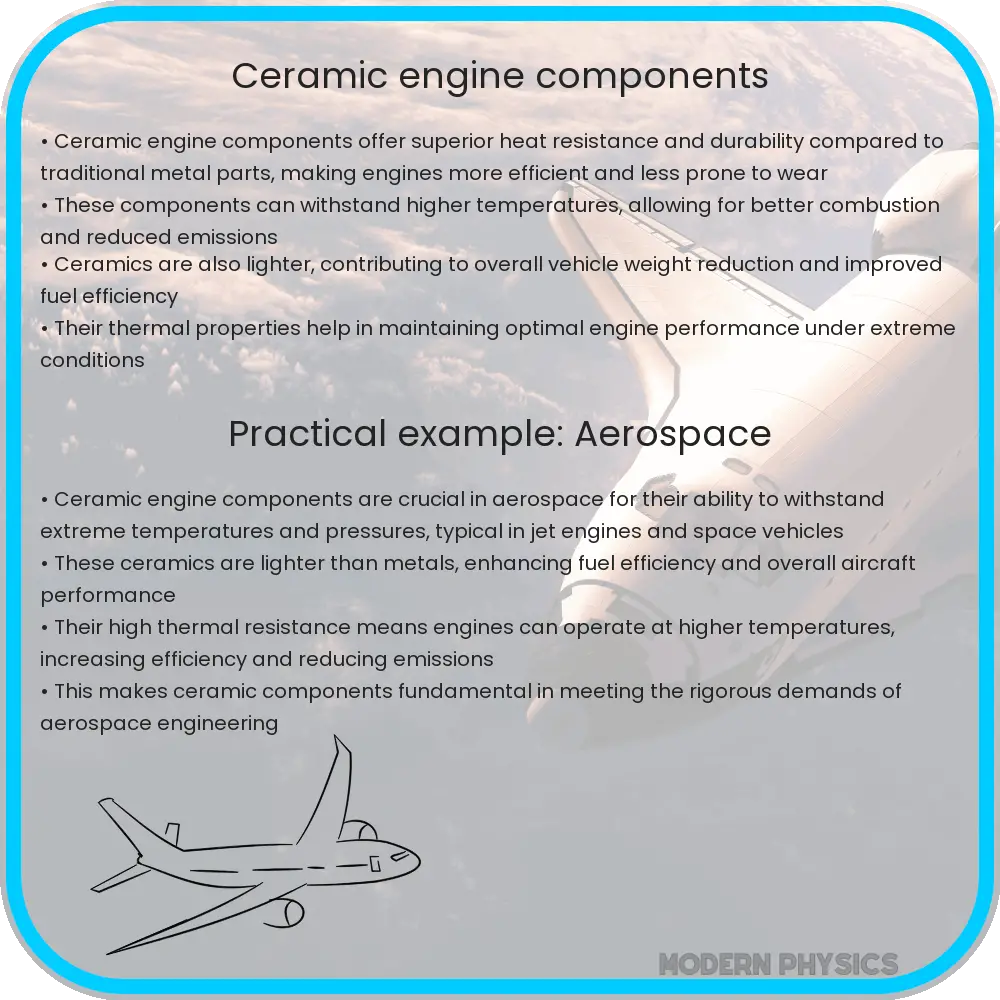Ceramic engine components offer increased durability, heat resistance, and efficiency in automotive and aerospace applications.

Introduction to Ceramic Engine Components
The evolution of engine technology is a cornerstone in enhancing the efficiency and performance of various mechanical systems, from automobiles to aerospace. One of the most significant advancements in this field has been the development of ceramic engine components. Ceramics, known for their exceptional heat resistance and durability, have introduced a new dimension to engine design and functionality. This article explores how ceramic materials contribute to the durability and efficiency of engines, along with the innovations they bring to the automotive and aerospace industries.
Understanding Ceramic Materials
Ceramic materials are inorganic, non-metallic solids that are made from powdered chemicals and are then formed into shapes through sintering at high temperatures. These materials are generally characterized by their hardness, brittleness, and heat resistance. The most commonly used ceramics in engine components include silicon nitride, zirconium oxide, and silicon carbide.
Durability of Ceramic Components
The durability of ceramic engine components is one of their most significant advantages. These materials can withstand extremely high temperatures, which typically degrade more conventional materials like metals. Ceramics maintain their strength even at temperatures up to 2000°C, which allows engines to operate at higher temperatures without the risk of damage. Furthermore, ceramic materials exhibit excellent wear resistance, which is crucial for the longevity of engine parts exposed to high friction environments.
- Heat Resistance: Ceramics can resist the thermal degradation that compromises the integrity of metal components at high temperatures.
- Wear Resistance: Hard ceramic surfaces are less likely to wear down or deform, keeping the engine components intact for longer periods.
- Corrosion Resistance: Unlike metals, ceramics are less prone to oxidative wear or corrosion from exposure to harsh chemicals.
Enhancing Engine Efficiency with Ceramics
Efficiency in engine performance is closely tied to how well an engine manages its heat and minimizes energy loss. Ceramic materials are excellent insulators and contribute significantly to thermal management in engines. By using ceramic components, engines can achieve higher combustion temperatures and more complete fuel combustion, leading to greater fuel efficiency and reduced emissions.
Additionally, the lighter weight of ceramic components compared to traditional metal parts reduces the overall weight of the engine. This weight reduction is particularly beneficial in fields like aerospace and racing, where every ounce saved contributes to speed and fuel efficiency.
- Improved Thermal Management: Ceramics help retain heat within combustion chambers, enhancing the efficiency of the burn process.
- Reduced Weight: Lighter engine components can lead to overall vehicle weight reduction, improving performance and fuel efficiency.
Innovations in Aerospace and Automotive Industries
The application of ceramic components extends well beyond general engine performance. In the aerospace industry, ceramics are used in the production of turbine blades that must withstand rapid temperature fluctuations and extreme heat. The durability and heat resistance of ceramics allow these turbine blades to perform more efficiently and with greater reliability, thereby enhancing the overall safety and performance of aircraft engines.
In the automotive sector, ceramic materials are increasingly used in brake systems and engine parts. The heat resistance of ceramics ensures that brake pads wear down less quickly and remain more effective under high temperatures, providing better braking performance and safety. Similarly, ceramic engine parts help in achieving higher engine performance with reduced maintenance costs and extended longevity.
- Improved Aircraft Engine Performance: Ceramic turbine blades help increase efficiency and dependability in aerospace engines.
- Enhanced Automotive Safety: Ceramic brake pads offer superior performance and durability, enhancing vehicle safety under diverse operating conditions.
Future Perspectives
The potential for ceramics in engineering applications continues to grow as technology evolves. Future developments could see the use of ceramics in more diversified fields such as renewable energy, where durability and efficiency are paramount. The research in nanoceramics and composite materials may lead to even lighter, stronger, and more adaptable components that could revolutionize the way engines and other mechanisms are designed.
Moreover, as environmental concerns drive the demand for more fuel-efficient and less polluting engines, ceramic components are poised to play a critical role. Their ability to operate at high temperatures without degradation can help significantly in the development of next-generation, eco-friendly engines.
- Renewable Energy Applications: Ceramic components in solar panels and wind turbines can enhance the efficiency and lifespan of these devices.
- Environmental Impact Reduction: Advanced ceramics can contribute to the production of cleaner engines with lower emissions.
Conclusion
Ceramic materials bring a blend of durability, efficiency, and innovation to the engineering field, revolutionizing traditional design and functionality paradigms in both the aerospace and automotive industries. The unique properties of ceramics—such as high temperature resistance, lightweight, and corrosion resistance—make them indispensable in modern engineering applications. With ongoing research and development, the potential of ceramics to further enhance engine performance and efficiency while reducing environmental impact is immense. Embracing these advanced materials could lead to the next leap in technological advancements, making engines more sustainable, efficient, and powerful than ever before.
